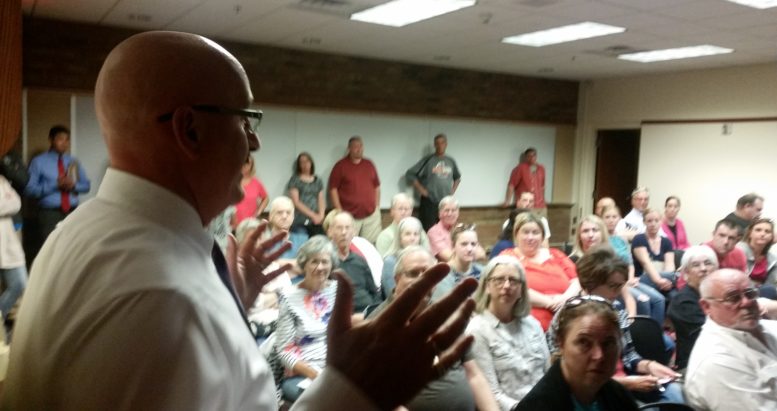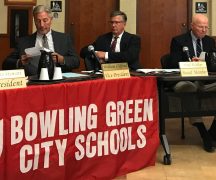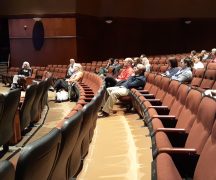By JAN LARSON McLAUGHLIN
BG Independent News
Bowling Green Superintendent Francis Scruci tried to stop the rumor mill from churning Monday evening. For 90 minutes, he presented details and answered questions from a packed meeting room at the public library about the school district’s building plans and the bond levy to support them.
Scruci has heard “all kinds of stories” about the district’s plans. “We wanted to get this information out now,” he said. “We want to get out in front of those” rumors about costs, cuts, kids and more.
So he started by explaining the building plans and the $72 million cost to taxpayers.
“I’m going to be the first to tell you that’s a lot of money, and we know that,” Scruci said. The 6-mill bond issue will appear on the November ballot for the projects.
“Schools are always going to be the investment in the future in every city,” he said. “If we kick the can down the road, the cost is going to grow.”
For the owner of a house valued at $100,000, that means an extra $210 a year. But since the average house value in Bowling Green is $170,000, Scruci said that would add up to $357 a year. And for those on the higher end, with a $250,000 home, the bond issue would mean another $525 a year.
When he said the bond issue was for 37 years, someone in the audience whistled.
“People are going to say that’s a lot of years, and it is,” Scruci said. But a bond issue with fewer years would mean greater payments that could be unmanageable for many residents.
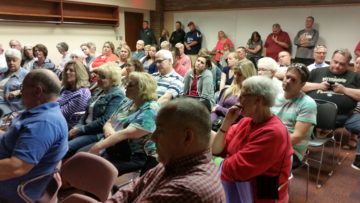
Meeting room was filled with citizens.
Scruci said he knows there are families in the district who will have difficulty paying the $210 a year.
“I know there are some people in this community who can’t afford this,” he said.
But Scruci maintained that the school district should not continue to put good money into old buildings that don’t have “good bones.” The board is not interested in taking state funding for construction, since the state would only contribute 11 to 13 percent, but would take control over the projects. The district is losing new students to newer schools. And Bowling Green students deserve better facilities.
“We owe it to every student in this district to give them the best education,” he said.
“Somebody paid for my education and it’s time for me to pay,” he said.
The building plans call for partial new construction and renovation of the high school, plus construction of a consolidated elementary school north of the existing middle school and high school complex.
If the bond issue passes in November, the elementary would be built in about three years, and the high school project could be done in three and a half years. No “swing space” would be needed, since students would stay in their existing facilities until the new buildings are constructed.
Plans call for Conneaut and Kenwood elementaries to be demolished, with that expense already included in the costs. Crim Elementary would be used as a central administration building, which would mean the district would no longer have to rent space for that purpose.
The high school plans call for construction of a new academic wing, kitchen/cafeteria and gymnasium. Scruci described that as people enter the doors by the main office, and walk straight past the cafeteria, everything to the south will be demolished and replaced with a new building. Everything to the north will be renovated.
There will also be more gym and practice space.
“We had kids practicing till 10, 10:30 at night,” due to lack of space. “That makes no sense academically.”
A new gym will be able to seat 2,000, compared to the current 1,200. That will allow for the district to bring in revenue by hosting athletic events. It will also allow the district to hold graduation at the school rather than pay to use BGSU’s Stroh Center, which costs as much as $7,000 for rental.
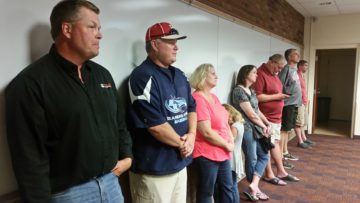
Residents listen from back of meeting room.
The high school project will take place in four phases, so as to disrupt students as little as possible. The first phase is construction of the new academic area. Scruci said he hopes to approach local businesses about adopting rooms, such as a company helping to pay for the science room – to take some of the pressure off taxpaying residents.
The second phase is the demolition of the existing academic areas. The third is construction of the kitchen/cafeteria and gym. And the fourth is renovation of remaining classrooms.
Scruci said by renovating a portion of the high school rather than building all new, the district was saving about one-third of the cost.
“Everybody agreed on one thing, something needs to be done,” he said.
Though the new high school will be air-conditioned, the project is about far more than that, Scruci said.
“We have to give kids the best that we can give them, and still live within our means,” he said.
Scruci also described the consolidated elementary plans. “This is the one that is creating the most questions.”
The centralized school will allow for more teacher collaboration, equity of resources, even class sizes, and elimination of labels. It will also be able to accommodate children with disabilities who now have to go elsewhere.
“Our teachers will be able to share and our kids will benefit,” Scruci said.
It has not yet been determined which model of a “school within a school” will be used at the elementary. It may involve having K-1, 2-3, and 4-5 “houses,” or two K-5 “houses.”
At the same time, the district is dealing with overcrowding at the middle school, which was built to handle two grades, but is currently housing about 750 sixth through eighth graders. The problem will worsen in a couple years when an abnormally large class entering fifth grade now reaches the middle school, pushing the student count close to 800.
The school board has decided to use permanent improvement money to pay for a $4.5 million addition to the middle school. That construction will start in mid to late August and be ready for the 2018 school start.
As the audience at the forum asked questions, Scruci faced some rumors head-on Monday evening.
“The rumor in the community is that those programs are being eliminated,” one citizen said about vo-agriculture classes and family and consumer science.
“No, that’s not true,” Scruci said, noting the vo-ag program at Bowling Green is the best of any school where he has worked. “Those are programs we have to keep sacred.”
How many teachers, custodians and other staff will be cut?
“We’re going to have the same number of teachers. Our goal is not to eliminate positions,” Scruci said. “We still have kids to serve.” If there are any cuts, it will likely be in administration, he added.
Will class sizes increase with the new consolidate elementary?
No, but class sizes will level out, since all the grade levels will be in the same building, Scruci said. So instead of having 24 students in a classroom at one elementary and 20 in a classroom in another, both would be balanced at 22.
Student drop-offs are already “crazy,” and will just get worse with one consolidated elementary, Rob Piasecki said. Scruci said plans are being devised to alleviate the problems and administrators will be asked to be more vigilant with people dropping off or picking up children, Scruci said.
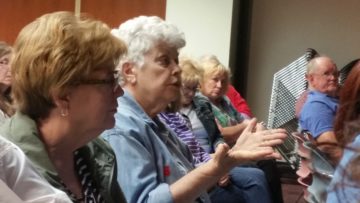
Barbara Keller offers suggestions for repurposing old elementary.
Other citizens made suggestions that could help the community save on construction. Barbara Keller offered that Kenwood Elementary could make a good site for a new senior center. The site is accessible and has plenty of parking.
Another person voiced concerns about two schools that turned into “eyesores” after the district no longer needed them. “Those buildings should have been demolished and sold,” he said.
Scruci assured that the district would not leave a building that would devalue surrounding property. “It’s not going to be a South Main,” he said.
Bud Henschen suggested that an income tax would be a more fair source of revenue for school buildings. Since the state does not allow income tax revenue to be used for buildings, Henschen recommended the district seek a change in the law.
“The bottom line is, we’ve got an immediate issue,” Scruci said. And the wheels of government don’t move very quickly.
Henschen also asked if the district was going to need to be back on the ballot for teacher raises.
“We will be on the ballot for operating dollars,” at some point, Scruci said. “Anytime a teacher gets a raise, it’s probably overdue.”
But Scruci reminded the audience that the district is losing tax dollars now every time a new prospective family is lost to another school district. Families often tour Bowling Green schools, then tour Perrysburg schools.
“The next thing we know, they are moving up there,” the superintendent said. “We’re producing a good product. But we’re losing families.”
The district wants residents to submit questions about the projects and bond issue at BGOHCitizens@gmail.com. Facts about the plans can be accessed at @BGOHCitizens on Facebook, Twitter and Instagram.

